Rebecca’s Recipe of the Week: Pasta with Creamy Carrot Miso Sauce
Another very good recipe from Slyvia Fontaine. The creamy carrot sauce colours the pasta a beautiful gold, while the fresh, herby gremolata adds vibrant green. Toasted breadcrumbs provide a contrasting crunch against the richness of the sauce. You would certainly not guess that this is vegan, but you’ll see right away how beautiful it looks in your bowl. The flavours work really well together and I recommend this highly.
Pasta with Creamy Carrot Miso Sauce
Serves 4
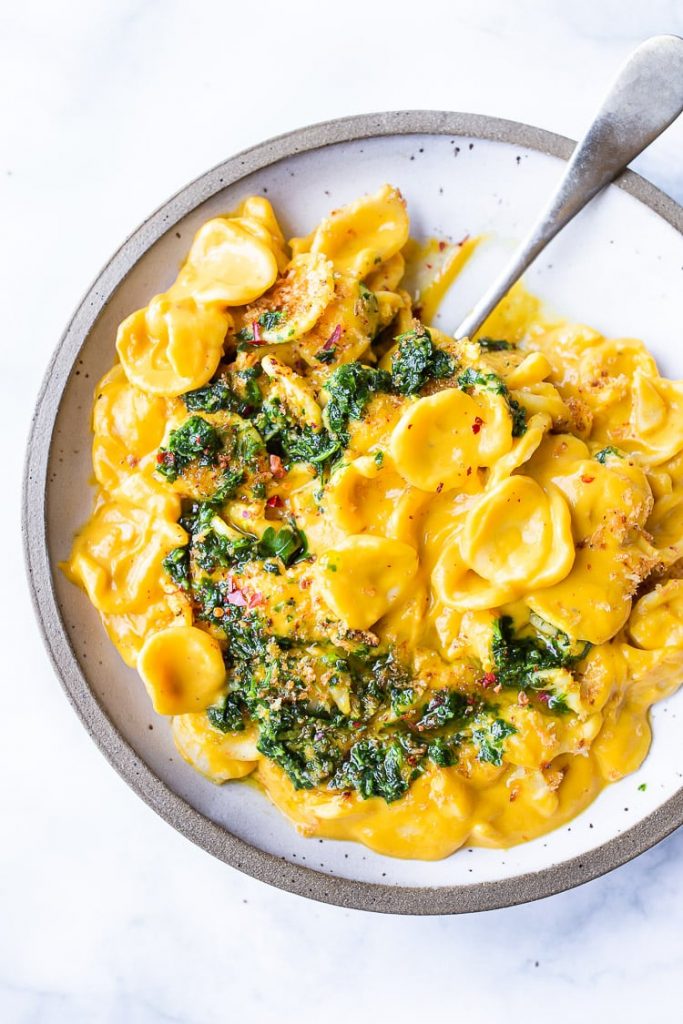
Ingredients
Carrot Miso Sauce
2 shallots, rough chopped (or 1/2 an onion)
3 large garlic cloves, rough chopped
2 tablespoons olive oil
150g carrots
450ml water
40g cashews
Freshly-ground pepper
3 tablespoons white miso paste
Gremolata
60g fresh coriander or parsley (Sylvia notes you can also use carrot tops)
1 tablespoon lemon zest ( zest from one medium lemon)
¼ teaspoon salt
1 fat garlic clove
70-100ml olive oil
Toasted Breadcrumbs
1 thick slice of good bread, grated, to make about 50g breadcrumbs
250g pasta (Sylvia Fontaine recommends orecchiette)
Instructions
Cook the sauce: Heat oil in a medium pot, over medium heat. Saute shallot and garlic until fragrant and golden, about 5 minutes, stirring often. Add carrots, cashews, water, and pepper and bring to a boil. Cover, lower heat to low and simmer gently until carrots are fork-tender, about 15 minutes. Stir in the 3 tablespoons of miso and let cool for 5-10 minutes.
While the carrots simmer make the Gremolata: Place coriander or parsley, lemon zest, salt and garlic in a food processer and pulse repeatedly until finely chopped. Add 70ml oil, pulsing a few more times until incorporated (but not too smooth). Add more oil if you prefer a looser version.
Now make the breadcrumbs: place the breadcrumbs in a frying pan over medium heat and toast, stirring frequently, until the crumbs are golden brown. Set aside.
Bring some water to the boil, and cook the pasta according to the packet instructions.
While the pasta is cooking blend the sauce: place the carrot-cashew sauce in a high-speed blender or food processor and blend on the lowest setting, gradually increasing speed, until fully blended, creamy and silky smooth, which will take between one and two minutes. Slyvia writes: ‘Take your time here and get it SMOOTH!!!’
Drain the pasta and pour the sauce over. Heat it gently if needed. Taste and adjust salt.
Divide among bowls, and sprinkle with toasted bread crumbs and spoon the gremolata over top. Enjoy with a glass of chardonnay.
Recipe adapted from Sylvia Fontaine, Feasting at Home
2020 – October news: Rat Attack
Here at Canalside we live in harmony with all of nature’s fauna and flora. However, some animals are getting a bit too harmonious for my liking: someone, or something, has discovered our squashes (which are seasoning in tunnel 3 just now) and invited all its friends and family for a squash party! We suspect the rat, so have set up live traps which so far have failed to entice the offender. Luckily not too many fruits have been lost so far.
Dom van Marsh
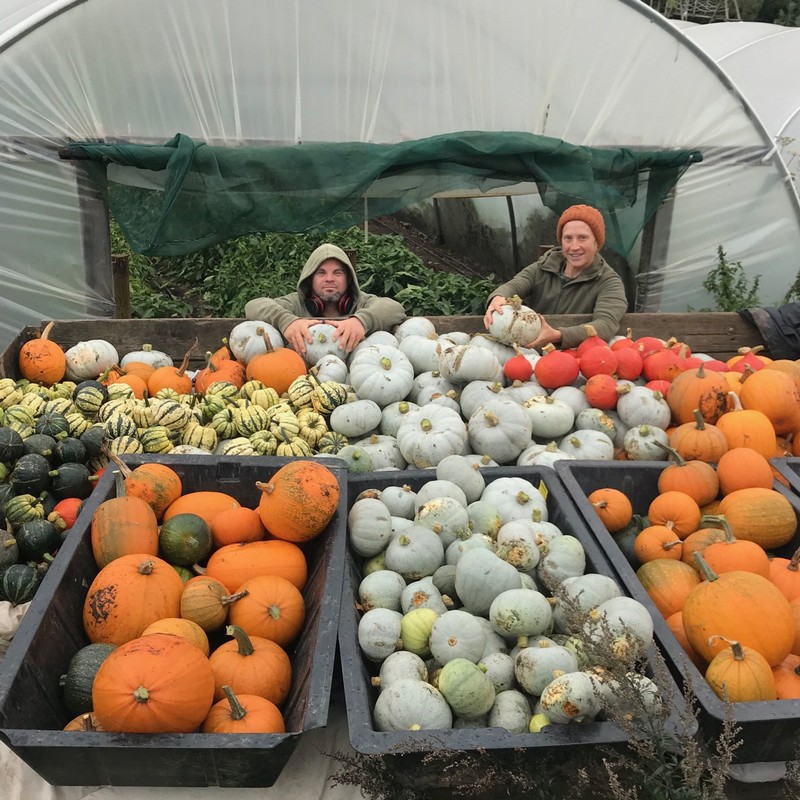
The squash haul being unloaded 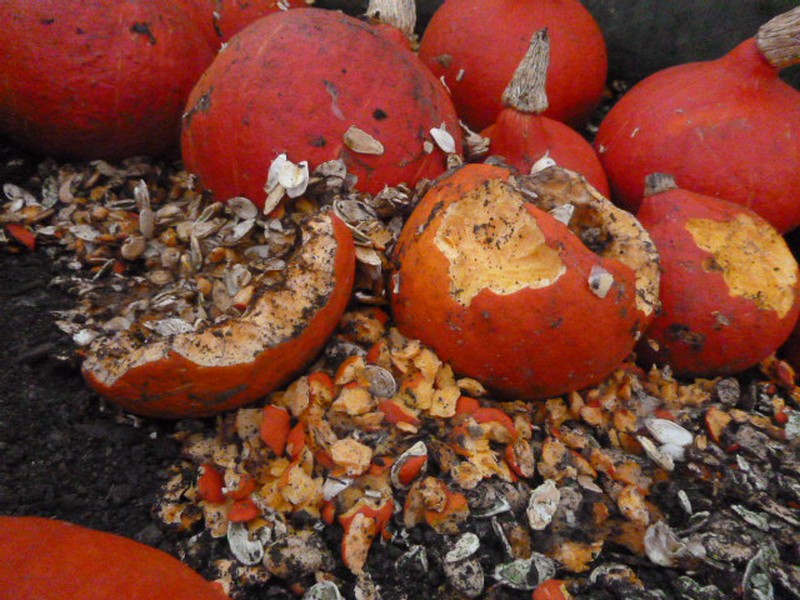
The post-party mess…!
Rob’s Recipe of the Week: A reason to buy mace?
Since starting recipes I tried my hardest to avoid running a “mashed swede” recipe but it had to happen eventually… This one looks good, although I’m going to have to go to the shops and buy some mace!
Honey crushed swede
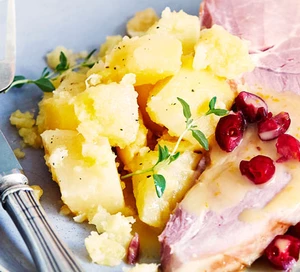
Ingredients
2 large swede , cut into 3cm chunks
1 tsp ground mace
100g butter
2 tbsp clear honey
Method
Put a pan of salted water on to boil. Add the swede and simmer for 20-25 mins until tender. Drain the swede, tip back into the pan and add the mace, butter and honey. Season and crush everything together gently with a potato masher.
from: BBC Good Food
Rebecca’s Recipe of the Week: Peas (and Salmon)
Peas cooked with onions and butter make an excellent dish to eat on their own. Add some pan-seared salmon fillets and you have an easy and very delicious meal.
(To pan-sear, dry the salmon carefully and then season liberally with salt. Heat a little neutral oil in a skillet, and when it is hot add the salmon, skin-side down. Press it into the pan with a fish so that it makes good contact with the heat. Cook, without moving the fish, for about 3 minutes, and then flip it over to cook the other side. Cook for an additional 1-4 minutes, depending on how cooked you like your fish.)
Peas with Parsley, Thyme, Butter and Onions
Serves 4 as part of a larger meal.
Ingredients
2 tablespoons neutral oil (rapeseed, sunflower seed etc.)
1 giant Canalside spring onion, thinly sliced (use the whole thing including the dark green leaves)
½ teaspoon salt
1/2 cup white wine
1 cup chicken stock
4 cups frozen (or fresh) peas
4 tablespoons butter
¾ cup fresh parsley, roughly chopped
5 springs of fresh thyme, roughly chopped
Preparation
Heat the oil in a large frying pan over medium heat. Add the sliced onion and the salt. Reduce the heat to low and cook until the onion is translucent and soft, but not brown. Add the wine and allow to reduce until almost completely dry.
Add the stock and bring to a boil. Add the peas and butter and cook until the stock has reduced, and the sauce is thick and silky with butter. Then add the parsley and thyme check for salt and pepper, and serve.
Recipe adapted from Abra Berens, Ruffage: A Practical Guide to Vegetables (2019).
Rob’s Recipe of the Week: Fast (and veggie) Bourguignon
You’ll have to nip to the shops for some mushrooms but otherwise, put with mash and greens, this recipe makes good use of lots of this week’s share. I’ve never made bourguignon so I’m looking forward to it!
Mushroom bourguignon
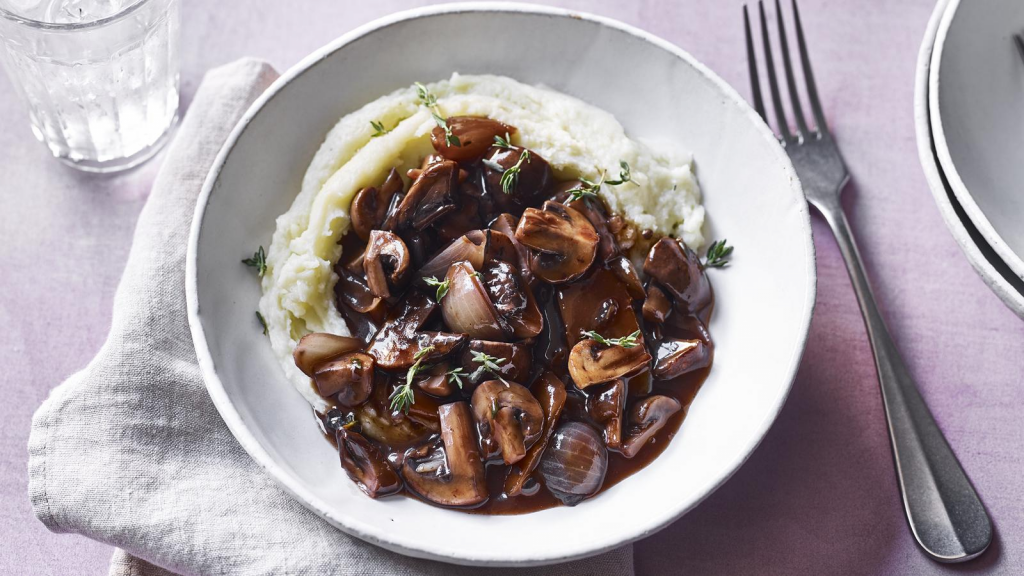
Ingredients
1½ tsp olive oil
3 shallots, peeled, quartered and layers separated
1 large carrot, peeled and cut into slices on an angle
100g/3½oz button mushrooms, quartered
50g/1¾oz chestnut mushrooms, quartered
3 Portobello mushrooms, roughly chopped
7 fresh thyme sprigs, leaves only, or 1½ tsp dried thyme
3 garlic cloves, finely chopped
150ml/¼ pint fruity vegan red wine
200ml/7fl oz vegetable stock
2 bay leaves
1 tbsp tomato purée
1 tsp yeast extract
1 tbsp cornflour, or plain flour
salt and freshly ground black pepper
Method
Heat the oil in a heavy-based saucepan over a medium heat. Add the shallots and carrot and fry gently for 5 minutes.
Add all the mushrooms and most of the thyme and cook for 5–6 minutes (note, an alternative is to dry fry the mushrooms before the other ingredients – they cook in their own juices, enhancing the flavour). Add the garlic and fry for a further minute.
Add the wine and bring to the boil. Simmer for 2 minutes, then turn the heat down and add the stock, bay leaves, tomato purée and yeast extract and stir. Sift in the cornflour and ½ teaspoon salt and whisk in well.
Cook for 7–8 minutes, then season with salt and pepper and add the rest of the thyme if preferred.
Serve with creamy mashed potatoes or a crunchy slice of crusty bread.
Taken from: BBC Good Food
2020 – September news: Skinned
‘To skin’ is one of those unusual verbs with two meanings that are the complete opposite of one another. The skin a rabbit is to remove the skin, but to skin a polytunnel is to put it on – as the land team (finally!) did to tunnel 1 on Monday. The main reason to replace the polythene cover is about opacity more than anything else – you can ‘clearly’ see this by comparing the transluscent new cover of tunnel 1 with its 13 year old, virtually opaque neighbour. This will give much better crop growth, particularly in winter. Canalside member Eleanor made a fantastic short video of the work, which you can view on vimeo.

Tunnel 1 – ready for its first skinning
Winter 2006/07 – photo Tom Ingall
Second skinning preps complete 
Watch the video of the skinning process
Credit to Eleanor Brown
Rebecca’s Recipe of the Week: Grilled Corn
When I was growing up in New York State, fresh corn on the cob was a familiar summertime treat. In my family we always, always, ate it boiled, with butter, salt, and pepper, and that is indeed an excellent way of preparing this delicious vegetable. (Just to be clear, you should boil your corn for no more than about five minutes, in plenty of water.) Here, however, is another equally excellent way to cook corn.
Grilled Corn
Serves 2
Ingredients
2 ears of corn
2 tablespoons rapeseed or other oil
1 teaspoon Spanish smoked paprika (sweet or hot, as you prefer)
½ teaspoon salt
Freshly-ground black pepper, to taste
Preparation
Preheat your grill to maximum heat.
Meanwhile, shuck your corn: peel away and discard the outer leaves and delicate thread-like silk.
Mix the oil, paprika and salt together and brush over the ears of corn.
Place the corn under the grill and grill for about 10 minutes, turning regularly, until it is a beautiful golden colour all over.
Remove from the grill, grind some black pepper over the cobs, and eat alongside your quelites a la mexicana or anything else that strikes your fancy.
Rob’s Recipe of the Week: Panzanella riffed
One of the benefits of so many of us working from home is that there’s more time to make a fancy lunch. This week I’ve enjoyed riffing on Panzanella themed recipes – you can adapt the one below to suit what you have in the fridge and the time you’ve got to make it.
Panzanella
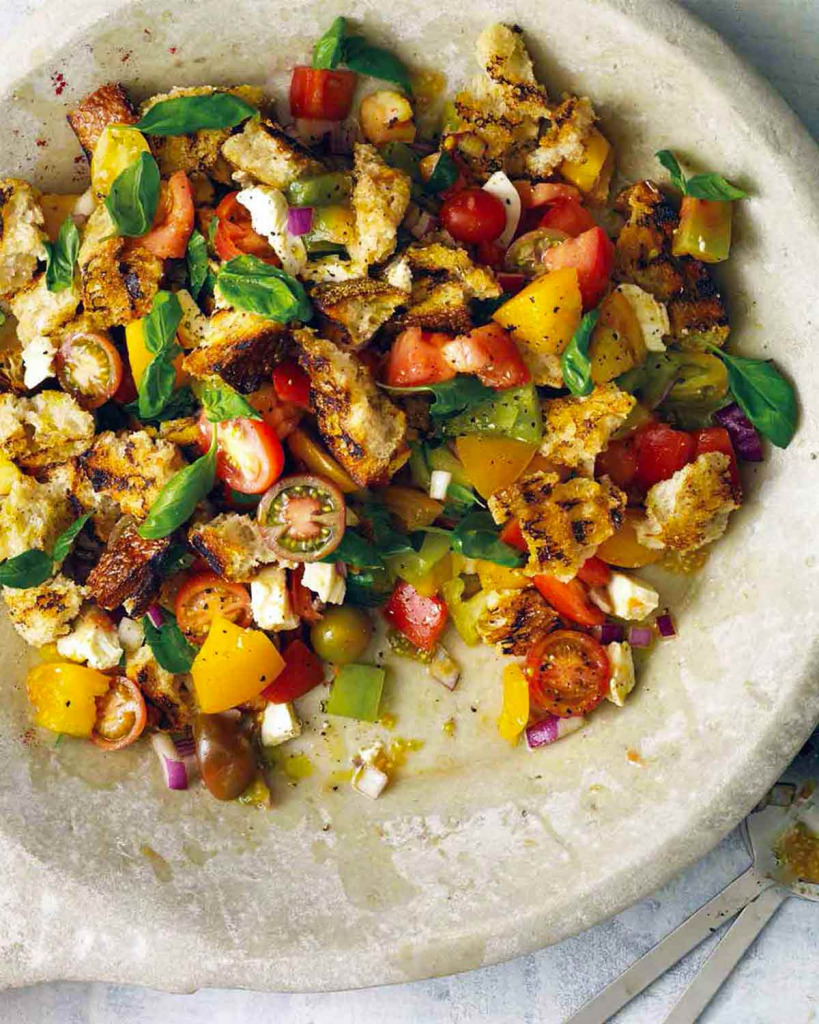
Ingredients:
3 tbsp olive oil
Splash red wine vinegar
day old bread, cut into 2cm cubes
1 tsp salt
2 large, ripe tomatoes, cut into 2cm cubes
1 cucumber sliced 1cm thick
1 or 2 peppers cut into 2cm cubes
1/2 red onion, thinly sliced
20ish large basil leaves, coarsely chopped
3 tbsp capers, drained
Method:
Heat the bread either by pan frying in oil if you have time, or 30s in the microwave if not. Then mix thoroughly with all the other ingredients in a large bowl, season and serve.
Rebecca’s Recipe of the Week: Mexican Greens with Potatoes and Flatbreads
In case you are wondering what to do with the mysterious ‘huauzontle’, here is the answer! Huauzontle, also known in Mexico as ‘quelites’, is a flavoursome green a bit like sprouting broccoli. In this recipe it is mixed with juicy tomatoes and cubed potatoes to make a superlative filling for a tortilla or other flatbread. Serve topped with thick yoghurt.
Quelites a la Mexicana
Serves 2
Ingredients
250g potatoes
250g huauzontle
200g onions
150g tomatoes
½ to 1 Canalside chile, deseeded if desired
1 tablespoon vegetable oil
1 teaspoon ground cumin
Yoghurt and flatbreads, to serve
Preparation
Put the potatoes in a saucepan and cover with cold water. Add a pinch of salt. Bring to the boil and cook until tender. Depending on the size of the potatoes, this can take between 20 and 40 minutes. Drain and let cool
Put the huauzontle in a saucepan and cover with cold water. Add a pinch of salt. Bring to the boil and cook until it’s tender, about 8 minutes.
Peel the onions and chop coarsely. Chop the tomatoes into chunks roughly the same size as the onions. Slice the chile.
By now the potatoes should be cool. Cut them into cubes, about 2cm or thereabouts.
Heat the oil in a frying pan or casserole pan. Add the onions, tomatoes and chile, and sauté for a few minutes. Add the cooked huauzontle, cubed potatoes and cumin, and sauté for a few more minutes to heat through.
Serve topped with yoghurt in flatbreads (tortillas would be traditional).
Recipe freely adapted from this fantastic video by Mexican internet sensation Doña Ángela. Many thanks to Ricardo Aguilar for his advice about cooking quelites and for telling me about Doña Ángela.
Rob’s Recipe of the Week: Maintaining Courgette Enjoyment
Every summer I treat the first courgette with excitement but as I’m sure is the case for everyone, my enthusiasm begins to wane as the summer goes on. To try and help with this myself and Rebecca have been trying out some more courgette recipes. My favourite so far is courgette fritters (sorry there’s a bit of a fritter theme at the moment!), they made for a reasonably quick work-from-home lunch.
Courgette fritters
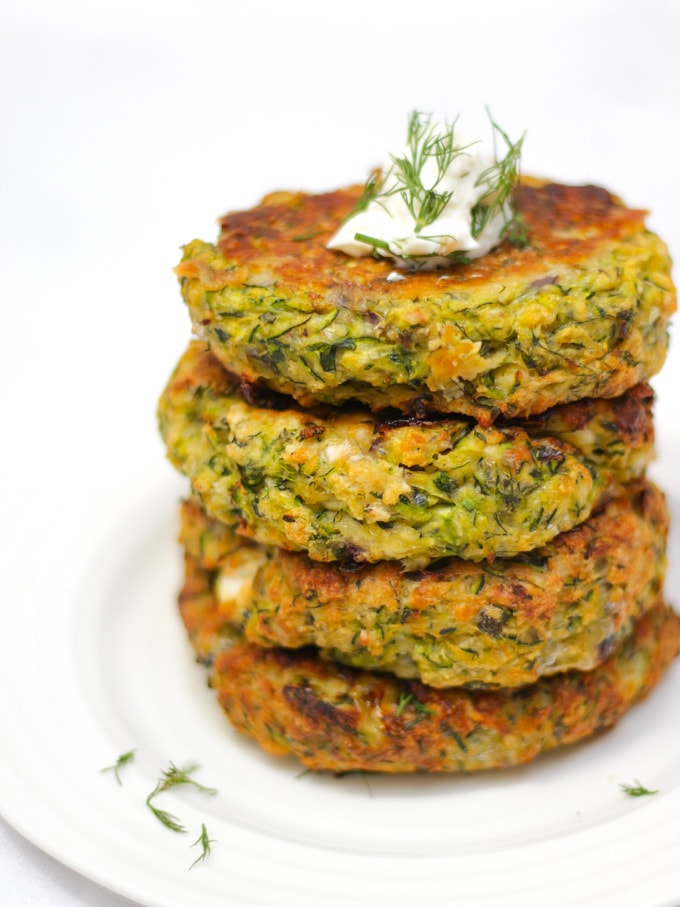
Ingredients (8 fritters):
1 kg Courgettes Grated
100 g Feta cheese Crumbled into big chunks
2 Medium free range eggs
2 Cloves Garlic Peeled and crushed
15 g Fresh dill Chopped
15 g Fresh mint Chopped
1 tsp Dried oregano
75 g Plain flour
200 g Breadcrumbs
1/2 Red onion Peeled and finely chopped
Fry light spray or Olive oil for greasing
Method:
Preheat the oven to 220C
Take your grated courgettes and over a colander, squeeze out as much of the liquid as you can. Use the colander and your hands, there will be lots!
When you’ve squeezed out the liquid, put all of your courgette fritter ingredients into a large bowl and mix well with clean hands.
Shape into 8 patties and put onto a greased (or sprayed using Fry Light) baking sheet. I got the strongest shapes by compacting a firm ball and then squash down into a disc
Bake for about 30 minutes of until browned, firm and cooked through (I fried them instead to speed things up)
From: https://www.tamingtwins.com/courgette-fritters-recipe/